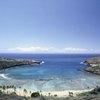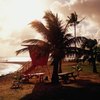A spectacular snorkeling experience, the kind where you easily view colorful fish by the dozens requires relatively calm, clear water and good habitat, such as coral or rocks. Most of Oahu's near shore places don't meet the requirements. There are a few places, though, on Oahu, including three close to Diamond Head, that offer fair to excellent snorkeling.
Lanikai
About 19 miles from Diamond Head, in the well-manicured neighborhood of Lanikai, you'll find an uncrowded, silky-sand beach dotted with palm trees. With its often calm, turquoise and blue waters, Lanikai lives up to its Hawaiian name for "Heavenly Waters." The coral reef embracing Lanikai is home to many tropical fish, from bright blue parrotfish with their beak-like mouths to fish that puff up when frightened to pretty-faced and yellow accented butterfly fish.
The visibility isn't great, but the abundance of marine life and ease of swimming here goes a long way toward making up for the sandy murk that arises with turbulence. For best visibility, go in the morning when the winds and ocean are normally at their calmest. Avoid snorkeling at low tide when it's impossible to snorkel directly over the reef. Park in the neighborhood. One of the best snorkeling spots is close to the public beach access path near the intersection of Mokumanu Drive and Kaiolena Drive. The gentle sandy entry makes it easy to pull on your fins after entering the water. The reef extends about 600 feet, but you can see coral and fish closer in. You will need to watch out for windsurfers but not nearly as many as at neighboring Kailua Beach Park, a popular spot with snorkelers.
Diamond Head Beach
You can't snorkel any closer to Diamond Head than here at the foot of the landmark crater, but whether you do may depend on how comfortable you are hiking down the road where pakalolo (Hawaiian for cannabis) smokers sneak puffs in their cars. The beach is a white sand strip between Beach Road and Diamond Head Lighthouse. The water is beautiful with blue changing to turquoise over the shallow reef. When the waves are small, snorkeling along the coral reef is good. A rock ledge provides interesting tide pool exploration, and surfers love it here too.
Hanauma Bay
If your visions of snorkeling near Diamond Head include being surrounded by schools of colorful fish as you float above coral reefs, and if you don't mind sharing this marine field trip with hundreds of other humans, add Hanauma to your itinerary. Coral reefs are important ecosystems that provide habitat to a wide diversity of animals, and in the protected Hanauma Bay Nature Preserve, (honolulu.gov) about eight miles from Diamond Head, more than 400 species of fish and other aquatic life thrive. Human visitors, gurgling barely intelligible exclamations through snorkels, are both educated and delighted as they point excitedly at a cloud of ink left from an octopus, a five-foot long turtle passing underneath, or a brightly colored school of fish separating around them.
To help preserve the reef and its tenants, Hanauma restricts hours to visitors, closes on Tuesdays and charges an admission fee. Its marine education center is a must see and a good way to educate yourself on the many fish that inhabit the reef: trumpets, trigger fish, moray eel, squid, honu and the endangered Hawaiian green sea turtle.
Considerations
Protect your valuables. Instead of leaving them on the beach, take them with you in a waterproof container. Help protect the reefs and marine animals by taking care not to touch the fragile coral. The coral reefs are a very important part of Hawaii's ecology. They provide habitats for many species, as well as areas protected from waves where humans can enjoy swimming and snorkeling. The coral reefs also help prevent erosion of shoreline. White sand beaches are created by coral. Some of the reefs seen when snorkeling took hundreds of years to develop and could be wiped out by carelessness. While snorkeling allows a person to float, a beginning snorkeler who doesn't feel comfortable without the support of something, such as standing on the reef while adjusting masks or such, should use a flotation device.
References
Resources
Photo Credits
- Medioimages/Photodisc/Photodisc/Getty Images




